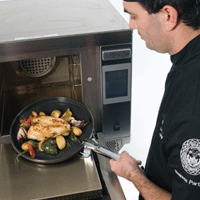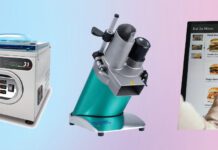Chefs serve up quick and delicious à la carte meals with new speed-cooking units
obert Bartley, executive chef and culinary director at Maple Leaf Sports & Entertain-ment in Toronto, feels like a kid in an electronics store these days. That’s because he’s been unpacking and test driving his newest shipment of speed ovens.
Having worked with speed-cooking equipment for close to five years, he’s blown away by how fast and efficient each new model gets. “It’s like buying a stereo or TV,” he says. “Every two years they get better and better. The older ones we have still work well, but they’re not as quick and efficient as our new units.”
Bartley isn’t the only operator expressing a need for speed these days. Customers are not only hungry, they’re starved for time, too, and they want their orders prepped faster than ever. But by the looks of the newest machines — not to mention the latest sales numbers — it’s clear that speed-cooking technology has officially come of age. And while these unassuming countertop units may not boast the most interesting designs, they pack enough power to cook, bake and brown items in seconds.
“They can do one-off items very, very quickly,” says Dave Wilson, corporate chef for W.D. College Co. Ltd. in Mississauga, Ont. “In a lot of places, they might be the only cooking unit a chef has, but they’re also becoming more useful for augmenting other pieces on the cooking line.”
For years, the uptake of speed-cooking appliances has been very strong in Europe, yet the technology has only recently taken hold in North America, says Mark Richardson, vice-president, Program Management Accelerated Cooking, for Merrychef in Fort Wayne, Ind. “When Subway took to toasting in 2004 and bought 30,000 units, it really validated accelerated-cooking technology.”
Sales for the newest TurboChef Tornado units have skyrocketed, Wilson says. “We’re seeing a lot more market penetration because of the convenience and speed.” He adds that new units can be 12-times faster than regular convection ovens, and they can be used in a variety of ways, from simple functions such as heating pre-cooked items like pizza to preparing fine-dining dishes.
Kim Gans, owner of the Sweet Flour Bake Shop in Toronto, has her own custom-designed collection of speed-cooking units that help her bake fresh, do-it-yourself cookies in just two minutes. “I saw an opportunity for my concept,” she says, “but I needed the right technology to make it work.”
“Every operator is looking for speed without compromising food quality,” agrees Walter Rosizky, national sales manager for Celco Inc. Food Service Equipment in Mississauga, Ont. “Speed-cooking equipment can still be used for traditional-style cooking — heating and browning, for instance — but it does it much faster and it lets you use metal pans. It’s a good alternative to microwaving,.”
Nevertheless, speed-cooking equipment wasn’t always as efficient and effective as the turbo-charged units available today. Microwaves first got the speed-cooking ball rolling, followed by microwave/con-vection systems, which do a fine job of heating and baking. With hot-air impingement or radiant heating added to the mix, speed cooking now turns out products that meet the quality needs of most foodservice applications — from roasting lean meats to baking cookies.
Bartley says by combining microwave, infrared and convection units, speed-cooking machines are 15-times faster than conventional ovens. “Basically, the convection pulls air through the grease filter, removes the particles and returns the air to the cavity to make the impingement plates super hot,” he explains. The units also allow the chef to program up to 256 different menu items and, since the equipment is ventless, it can be used almost anywhere. He says his four Merrychef 402S units (adding to the five he already has) cost $9,000 apiece and they’re currently being used in two new concessions to make pizza dogs and panini sandwiches, while others are used in the Air Canada Centre’s sports bar.
The quick-toasting factor may have played a big part in bringing speed-cooking equipment to the forefront, but one shouldn’t discount the influence of recent technology improvements, alongside the typical operator’s need to adapt to changing economic times. “Speed cooking is moving to the next level right now,” Merrychef’s Richardson says. “The addition of impingement technology to convection/microwave functionality makes the units even faster and helps them deliver a better finish, whether you’re talking convenience foods or fine dining.” The machines also incorporate the latest catalytic technology, which eliminates grease and the need for separate extraction and ventilation systems.
Another benefit of the new units (which have prices ranging from $6,000 to $10,000) is that they feature handy icon-driven menu screens so users can simply press a button to select the item they want to cook. Internet capabilities are also being integrated into the mix. For example, Merrychef’s newest addition to its eikon series just won an NRA 2010 Kitchen Innovation Award for its icon-driven menu, along with Ethernet connectivity for improved management and uploading and downloading of data to POS systems.
“Icon-driven menus help operators overcome language barriers, which is important in an industry where labour is diverse and turnover is high,” Richardson says. “It also allows you to have different seasonal menus, but most importantly, it reduces training times.” In fact, instructional guides are built into the touch-screen functions. “Once these machines are programmed, anyone with zero technical training can use them,” Wilson adds.
“All our employees need to know is how many cookies they’re baking,” agrees Gans. “The learning curve is that easy.”
Elbow room is another important factor behind the surge in speed-cooking sales, as operators are always looking for technology that’s smaller and more efficient. “Operators are focused on working with new technologies to help them get more out of their kitchens, reduce labour and waste costs and save energy, all while delivering food faster to increase table turnover,” Richardson says.
And an efficient business is usually a good business. “You can eliminate a $4,000 convection oven and a $5,000 microwave and replace them with one [speed-oven] unit that costs $4,000 to $12,000, depending on your needs,” W.D. College’s Wilson says.
Nursing homes, in particular, have been using more speed ovens as the concept of the single dining room disappears in favour of serveries that cater to smaller groups of residents (i.e., 25 or less). Sandra A. Matheson, president of Food Service Consulting Inc. in Oakville, Ont., says she’s been working with the combination of Amana Convection Express speed ovens for cooking and baking with a high-wattage microwave for steaming vegetables. She believes the combination is an ideal fit for the decentalized servery model. “In both cases, the equipment doesn’t require ventilation,” she says. “More importantly, it takes us away from the concept of retherming food — which is really just reheating — to actual cooking.”
And because the equipment is ventless, it can be set up in virtually any location, including quick-serve kiosks, convenience stores, gas stations, pubs and movie theatres. Wilson reports seeing more units being used in hotels, since they assist kitchen staff move orders out more quickly and ease congestion, as well as allow chefs to add a wider variety of upscale items to room-service menus.
Best of all, says Matheson, “they’re sturdy, durable and quick. They’re just about the most versatile things out there.”
Robert Bartley, executive chef and culinary director at Maple Leaf Sports & Entertain-ment in Toronto, feels like a kid in an electronics store these days. That’s because he’s been unpacking and test driving his newest shipment of speed ovens.
Having worked with speed-cooking equipment for close to five years, he’s blown away by how fast and efficient each new model gets. “It’s like buying a stereo or TV,” he says. “Every two years they get better and better. The older ones we have still work well, but they’re not as quick and efficient as our new units.”
Bartley isn’t the only operator expressing a need for speed these days. Customers are not only hungry, they’re starved for time, too, and they want their orders prepped faster than ever. But by the looks of the newest machines — not to mention the latest sales numbers — it’s clear that speed-cooking technology has officially come of age. And while these unassuming countertop units may not boast the most interesting designs, they pack enough power to cook, bake and brown items in seconds.
“They can do one-off items very, very quickly,” says Dave Wilson, corporate chef for W.D. College Co. Ltd. in Mississauga, Ont. “In a lot of places, they might be the only cooking unit a chef has, but they’re also becoming more useful for augmenting other pieces on the cooking line.”
For years, the uptake of speed-cooking appliances has been very strong in Europe, yet the technology has only recently taken hold in North America, says Mark Richardson, vice-president, Program Management Accelerated Cooking, for Merrychef in Fort Wayne, Ind. “When Subway took to toasting in 2004 and bought 30,000 units, it really validated accelerated-cooking technology.”
Sales for the newest TurboChef Tornado units have skyrocketed, Wilson says. “We’re seeing a lot more market penetration because of the convenience and speed.” He adds that new units can be 12-times faster than regular convection ovens, and they can be used in a variety of ways, from simple functions such as heating pre-cooked items like pizza to preparing fine-dining dishes.
Kim Gans, owner of the Sweet Flour Bake Shop in Toronto, has her own custom-designed collection of speed-cooking units that help her bake fresh, do-it-yourself cookies in just two minutes. “I saw an opportunity for my concept,” she says, “but I needed the right technology to make it work.”
“Every operator is looking for speed without compromising food quality,” agrees Walter Rosizky, national sales manager for Celco Inc. Food Service Equipment in Mississauga, Ont. “Speed-cooking equipment can still be used for traditional-style cooking — heating and browning, for instance — but it does it much faster and it lets you use metal pans. It’s a good alternative to microwaving,.”
Nevertheless, speed-cooking equipment wasn’t always as efficient and effective as the turbo-charged units available today. Microwaves first got the speed-cooking ball rolling, followed by microwave/con-vection systems, which do a fine job of heating and baking. With hot-air impingement or radiant heating added to the mix, speed cooking now turns out products that meet the quality needs of most foodservice applications — from roasting lean meats to baking cookies.
Bartley says by combining microwave, infrared and convection units, speed-cooking machines are 15-times faster than conventional ovens. “Basically, the convection pulls air through the grease filter, removes the particles and returns the air to the cavity to make the impingement plates super hot,” he explains. The units also allow the chef to program up to 256 different menu items and, since the equipment is ventless, it can be used almost anywhere. He says his four Merrychef 402S units (adding to the five he already has) cost $9,000 apiece and they’re currently being used in two new concessions to make pizza dogs and panini sandwiches, while others are used in the Air Canada Centre’s sports bar.
The quick-toasting factor may have played a big part in bringing speed-cooking equipment to the forefront, but one shouldn’t discount the influence of recent technology improvements, alongside the typical operator’s need to adapt to changing economic times. “Speed cooking is moving to the next level right now,” Merrychef’s Richardson says. “The addition of impingement technology to convection/microwave functionality makes the units even faster and helps them deliver a better finish, whether you’re talking convenience foods or fine dining.” The machines also incorporate the latest catalytic technology, which eliminates grease and the need for separate extraction and ventilation systems.
Another benefit of the new units (which have prices ranging from $6,000 to $10,000) is that they feature handy icon-driven menu screens so users can simply press a button to select the item they want to cook. Internet capabilities are also being integrated into the mix. For example, Merrychef’s newest addition to its eikon series just won an NRA 2010 Kitchen Innovation Award for its icon-driven menu, along with Ethernet connectivity for improved management and uploading and downloading of data to POS systems.
“Icon-driven menus help operators overcome language barriers, which is important in an industry where labour is diverse and turnover is high,” Richardson says. “It also allows you to have different seasonal menus, but most importantly, it reduces training times.” In fact, instructional guides are built into the touch-screen functions. “Once these machines are programmed, anyone with zero technical training can use them,” Wilson adds.
“All our employees need to know is how many cookies they’re baking,” agrees Gans. “The learning curve is that easy.”
Elbow room is another important factor behind the surge in speed-cooking sales, as operators are always looking for technology that’s smaller and more efficient. “Operators are focused on working with new technologies to help them get more out of their kitchens, reduce labour and waste costs and save energy, all while delivering food faster to increase table turnover,” Richardson says.
And an efficient business is usually a good business. “You can eliminate a $4,000 convection oven and a $5,000 microwave and replace them with one [speed-oven] unit that costs $4,000 to $12,000, depending on your needs,” W.D. College’s Wilson says.
Nursing homes, in particular, have been using more speed ovens as the concept of the single dining room disappears in favour of serveries that cater to smaller groups of residents (i.e., 25 or less). Sandra A. Matheson, president of Food Service Consulting Inc. in Oakville, Ont., says she’s been working with the combination of Amana Convection Express speed ovens for cooking and baking with a high-wattage microwave for steaming vegetables. She believes the combination is an ideal fit for the decentalized servery model. “In both cases, the equipment doesn’t require ventilation,” she says. “More importantly, it takes us away from the concept of retherming food — which is really just reheating — to actual cooking.”
And because the equipment is ventless, it can be set up in virtually any location, including quick-serve kiosks, convenience stores, gas stations, pubs and movie theatres. Wilson reports seeing more units being used in hotels, since they assist kitchen staff move orders out more quickly and ease congestion, as well as allow chefs to add a wider variety of upscale items to room-service menus.
Best of all, says Matheson, “they’re sturdy, durable and quick. They’re just about the most versatile things out there.”





















